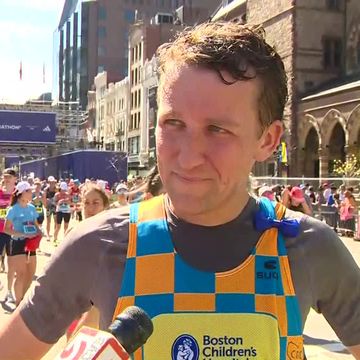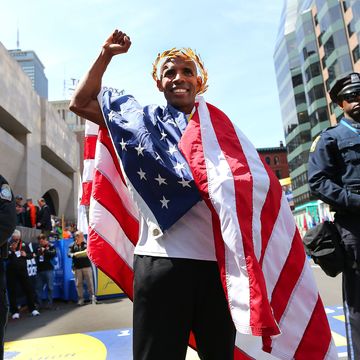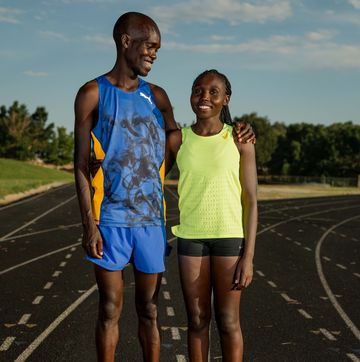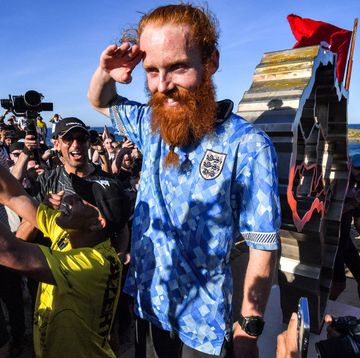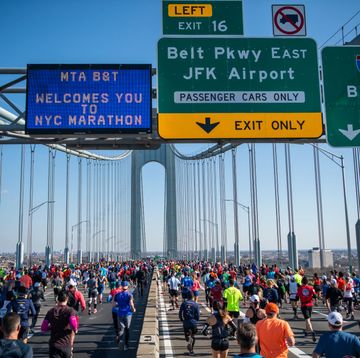On Friday, Temple University announced the elimination of seven athletic programs, including men’s indoor and outdoor track and field. The cuts are effective July 1, 2014, and will reduce the school’s varsity offerings from 24 programs to 17. Temple will also discontinue baseball, men’s crew, men’s gymnastics, and two women’s sports: softball and rowing.
In a press release, the school cited “the rising costs of doing business in intercollegiate athletics” as a driver for the cuts. The recommendation for the cuts came from Kevin Clark, Temple’s vice president and director of athletics, and was approved by university president Neil D. Theobald and the Board of Trustees following a seven-month analysis of the school’s athletic programs. The cuts will impact 150 student-athletes and nine coaches. An FAQ document posted by the school listed “student-athlete welfare, financial commitments (scholarships, operating costs and salaries), facilities and Title IX” as factors.
The move comes 17 months after the University of Maryland cut seven sports, including men’s indoor track and field and cross-country, because of a budget deficit, and in the wake of several other similar announcements at NCAA Division I schools.
In its latest issue, Runner’s World investigated this troubling trend—and why there might be cause for hope from within the NCAA’s lower divisions. We present that story here, with additional reporting to come as the Temple story develops.
Running programs have been discarded at top-tier NCAA schools but are being added at small ones such as Colorado Mesa (in white). (Photos by Thomas Prior)
Grand Junction High School's outdoor track is easy to miss. The unremarkable brick-red oval, occupying the rear corner of campus, is wedged into a quiet neighborhood of modest one-story homes with brown, winter-parched lawns. The cracks in the adjacent parking lot jostle my rental car as I pull up in front of a small marquee that reads: A WISE MAN FINDS A WAY. (The "Y" is actually a "V" stacked on top of an "I.") The last bell won't ring for another hour, so the lot is a ghost town. Close by, a flimsy metal gate marks the entrance to the track. I half expect a tumbleweed to blow by as I enter.
Two dogs jet across the infield in pursuit of a tennis ball. A third is tethered to a wooden bench. Beyond the furry scrum, I spot the runners I've come to observe: the Colorado Mesa University men's track team. They and the women's team members are just arriving for practice, emerging from cars parked on the residential street at the other end of the track.
As the Mesa Mavericks warm up, I sidle up to head men's track-and-field coach, Matt Canterbury, who, at 36, could pass for a student if not for a shock of gray in his boyish bangs. He points out the team leaders. There's Gus Barnes, a quiet, rock-jawed sprinter with a blond buzz cut; he hails from just across the New Mexico border. Trotting past us, their breath crystallizing in the chilly February air, are the other two, who are also cross-country captains: "Little John" Cusick, a feisty, red-faced distance runner from downstate Bayfield, and Shane Niksic, an upbeat, blue-eyed middle-distance star from the small mountain town of Conifer. He sports a weeks-old mohawk.
Like their teammates, all three are walk-ons, having joined the team when it launched during the 2011 to '12 school year. (The women's team debuted in 2006.) Niksic was instrumental in persuading the school to get a men's team and was active in the initial recruitment. "We went out there and found everybody who had a pair of running shoes," he'll tell me later.
This weekend, the Mavericks will compete in the biggest meet of their lives—the Rocky Mountain Athletic Conference Indoor Championships. In 2012, only 10 Mesa men competed on an "exploratory" basis; this year, 24 men and 22 women will travel by bus to the meet in tiny Spearfish, South Dakota, some 600 miles away. The RMAC, boasting two national distance-running powers in Colorado's own Adams State University and Western State Colorado University, is one of the most competitive conferences in all of NCAA Division II (the college sports association's second-tier level). Niksic, incredibly, has a chance to qualify for the D-II national championships in the 800 meters. His season's best time of 1:52.01 ranks 11th in the country, and he'll advance if his best remains top-16 after the weekend of conference meets all across the country.
Niksic and Cusick finish a rep and erupt into a miserable coughing fit—a side effect from spending their entire indoor season outside. Grand Junction, in the high desert, has cold, dry winters—but it can snow, as the white storm clouds shrouding the nearby cliffs suggest. Still, Canterbury says, they're lucky to even have this space; last year, they scrounged for time at the city's football stadium and multiple area high schools and middle schools, sometimes sharing space with more than a hundred teens and preteens. The university finally struck a deal to build this oval for the Mavericks to share with Grand Junction High. One day, Canterbury hopes they'll get their own track that, unlike this one, would have steeple pits and regulation jumping lanes so that they could host NCAA-sanctioned meets.
The team churns through practice with surprising discipline, but everything else here is unapologetically amateurish, even by D-II standards. And that, paradoxically, is what makes the Mavericks so novel in today's college sports landscape. That's what makes these runners vital examples for the fundamentally flawed NCAA.
+ + +
One after another over the last few years, NCAA Division I men's track and cross-country teams have been getting whacked. There was the highly publicized elimination of the University of Delaware's men's running program in 2011. Then, in the summer of 2012, the University of Maryland ditched men's cross-country and indoor track and field, and gave outdoor track and field an ultimatum to raise more money if it hoped to survive. In the fall of 2012, the University of Richmond gave their men's indoor and outdoor track teams the hook. Last spring, within days of each other, the University of North Carolina at Wilmington cut men's indoor track and field and cross-country and Coastal Carolina University announced it was cutting men's outdoor track and field and cross-country. In the last decade, D-I has had a total net loss of 29 men's track and cross-country teams. Apart from annual championships, the best news to come out of collegiate running circles of late has been no news.
These cuts should matter to runners for a few reasons. First, every time a track or cross-country program gets cut instead of, say, a football or basketball team, it reinforces the faulty notion that running sports are second-rate—that it's less messy to kick the runners to the curb. They won't fight as hard. Maybe this doesn't directly impact the 40-year-old marathoner in Newark, Delaware, but what might it say to his seventh-grade son? What kind of competitive cases can track or cross-country make for themselves if they no longer exist at the university down the road?
Second, actual runners who have poured their lives into the sport have had it snatched away without warning. Consider spraining your ankle the week of a race or a last-minute cancellation. Except losing your team is far worse: For many of these young men, running was why they enrolled at that school in the first place, with many relocating far from home. Their whole lives were upended.
Most of the damage, however, has occurred in D-I, the NCAA's most visible and elite level. Meanwhile, a counter-revolution is happening in D-II and D-III, where Colorado Mesa's men's cross-country and track teams are among the 273 men's running teams added in the last decade.
There are actually more NCAA runners now than ever—more than 82,000. That's up from about 63,000 a decade ago and about 48,000 two decades ago. America is still having its "second running boom," with a record 15.5 million people finishing races last year, so it would make sense that the NCAA, which enrolls more than 450,000 college athletes, would feel an effect. Thanks to Title IX, young women have never had a better chance to run in college. (Congress enacted Title IX in 1972 to protect against gender discrimination in federally funded education programs and activities, including athletics.) About 26,000 participated in outdoor track last year—more than double the total from 20 years ago and tops among all NCAA women's sports. Women's cross-country among the most widely available, offered at 94 percent of schools. Men's numbers have also grown, with more than 40,000 outdoor track and cross-country runners, up 25 percent in the last decade. Most of that growth, though, has been at the NCAA's lower levels.
One factor influencing the D-I men's cuts has been that, even 41 years after Title IX became law, most schools still struggle with gender equity. So when push comes to shove and a cut must be made, it often comes from the men's side. Though Title IX has slashed the gender gap since 1972, when there were nearly six male athletes to every female athlete, men still control 57 percent of NCAA varsity spots and 54 percent of student aid—even though most students are women. In D-I's Football Bowl Subdivision (the super-elites), the median expense per male athlete is $76,000, about twice what's spent per female athlete. D-II and D-III have their own participant ratio issues but have avoided controversy due to their lower profiles—and also because schools like Mesa continue to add sports.
When Delaware and others, like James Madison University in 2006, have cited Title IX as the reason for men's cuts, it has ignited vitriolic backlash against the legislation. It has become such a sore spot for some members of the running community that even when a Richmond or Maryland doesn't blame Title IX, angry fans still find a way to make it a scapegoat. (Search "Title IX" on the letsrun.com message boards.) The fact is, the Department of Education, which enforces Title IX, has made compliance easy: If a school's athletic opportunities (i.e., varsity spots) are not proportionate to its gender ratio on campus, it can comply by showing that it has continued to expand women's opportunities over the years. If it can't even do that, it can still comply by proving that the athletic needs of its female students are being met. "The women's community empathizes enormously with men who are finding that their opportunities are being restricted," says Karen Morrison, the NCAA's director of gender inclusion. "We're compatriots, frankly, in that."
The culprit isn't Title IX. It's greed. D-I schools—unlike the vast majority of their D-II and D-III peers—also compete at the box office, and prioritize the sports that have the best chance of making money: football and men's basketball. NCAA president Mark Emmert makes this point abundantly clear on his association's Web site (on a page unironically–we think—titled "On the Mark"):
"As a president, I say to my women's golf fans, 'The most important thing you can do is buy football tickets.' If you love rowing, buy football tickets. If you love cross-country, buy football tickets. We couldn't do any of those other sports if we weren't successful in football. In the NCAA, we can't support anything else we love unless we're successful in Division I men's basketball. Whether you like that or not, it's just a fact."
Except that isn't true. Less than a third of D-I football teams and less than a quarter of D-I basketball teams make money. And these ratios have held fairly steady for close to a decade. In all, only 23 D-I athletic departments out of 340 ended in the black in 2012. Nearly all of the ones that do make money compete in the Football Bowl Subdivision, but the FBS, in fact, has the biggest losers of them all: Last year, it had 53 unprofitable football teams, and the median one flushed away $3.4 million. That team's losses alone could, based on median costs, support four FBS-level men's running programs.
Virtually no D-II or D-III schools profit from sports, and yet they're adding teams. Steve Taylor, who coached Richmond's men through their final track season last spring, questions the motives in D-I. "Is it all about the dollar?" he asks. His young men had made the NCAA All-Academic Team Honors list nine straight years, and that didn't seem to matter. "Is that what it comes to? You only care about how far you can be in the black? Or do you care about the true purpose of athletics—to educate our young people? In some places, I think, one carries more weight than the other."
The Knight Commission on Intercollegiate Athletics, a powerful NCAA watchdog group, published a damning study of the D-I structure and governance issues in August that agreed, concluding: "The quest for revenue in Division I is undermining academic and institutional ideals. The escalating expenses in college football were specifically cited as causing extreme financial stress on programs that do not generate enough external revenue to cover expenses, resulting in funds being transferred from other sports and from the academic enterprise."
It's not hard to connect Emmert's statement about football tickets, then, to another refrain he has adopted ahead of a critical NCAA Convention this month: "The only thing everybody agrees on with Division I governance," he said in September, "is that it doesn't work."
The money has supplanted the mission in D-I. And matters may only get worse depending on what will, one way or another, be a landmark decision in O'Bannon v. NCAA, wherein former and current athletes are suing the association for a cut of the bonanza profits shared by a fortunate few conferences. (In September, the plaintiffs reach a confidential settlement with prior defendants EA Sports and the Collegiate Licensing Company to compensate college athletes for the use of their images and likenesses in video games and retail sales.) When NCAA leaders convene from January 15 to 18 to debate, among other things, ways to overhaul their system, they ought to look at why their cash-poor peers in D-II and D-III are thriving. The bootstrapping runners at Colorado Mesa should be Exhibit A.
Colorado Mesa's new men's track program practices with the women's team at a nearby high school. Gus Barnes (passing baton), now a junior, hopes his work ethic rubs off on his younger teammates.
The Mavericks have gone off the grid. The at-capacity charter bus has been on the road seven hours, and now it plods through the barren eastern plains of Wyoming—an alien land devoid of cell phone signal or any discernible life forms. We're still six hours from Spearfish and the athletes have gotten punchy. Some of them film a "Harlem Shake" video; others crack jokes. ("What's the state tree of Wyoming?" riddled then-junior heptathlete Randy Brown. "The telephone pole.")
We'd set off at 5:45 this morning, with stars still dotting the black sky. All week Canterbury had kept a worried eye on a snowstorm brewing in the mountains, paying close attention to the Vail Pass. As Interstate 70 carves through the Rockies, the Pass, at 10,617 feet, connects all points east and west of the divide. Last year on a trip to Colorado Springs, a blizzard shut it down, stranding the team at a Walmart for four hours. The weather worsened the higher we climbed, with near-whiteout conditions at the crest of the Pass. But we survived the snowy gauntlet, not to mention the driver's attempt at humor: "Does anyone know how to equip tire chains?"
Across the aisle, Gus Barnes digs into a 350-page crime novel. He grew up in New Mexico near the Southern Ute Indian Reservation but went to high school an hour away in Durango, Colorado, because of the poor quality of the local system. He played football and ran track at Durango High, but by the time he graduated, he was burned out on sports. He ignored a few letters of interest for track and enrolled in the University of New Mexico's construction-management program to follow his father into the industry. "I decided to experience school without being an athlete for a year," he says. "I hated it. It was hard to stay motivated."
He struggled at New Mexico and transferred to Mesa for a change of scenery. Shortly thereafter, he learned Mesa was forming a track team, and by then he was hungry for the rush of racing. He embraced the challenge of helping mold a new program. "Starting off with a fresh team, you get to set a standard for how things are done," he says. "I'm just happy to be able to run again."
Cusick, earbuds in, is uncharacteristically quiet. My first night in town, Niksic had invited me to the team's weekly dinner. Cusick showed up wearing stud earrings and a flat-bill Miami Marlins cap and spent the night debating everything from which NFL stars could hang with Usain Bolt to how many of Mesa's guys would get smoked by Mary Cain (to be fair, he counted himself).
Cusick came to Mesa after a frustrating dismissal from D-I Northern Colorado's track and cross-country teams. The coaches told him they didn't like him playing pickup basketball. Cusick suspects the real reason was a calf injury that had lingered since his days at Bayfield High. It turned out to be a dangerous case of compartment syndrome. "The doctor said the fact that I was even running was a shock," he told me. After surgery, Cusick transferred to Mesa with a chip on his shoulder. All season, he's been pounding out 95-mile weeks—by himself—to try and catch up with the conference's top-shelf distance competition.
And, oh, can these RMAC kids run. If starting a program from scratch isn't hard enough for Mesa, trying to hang with Adams and Western sure is. The two schools have combined to claim 17 of the last 21 national cross-country titles, and are no slouches in track and field, either. Adams won the 2012 outdoor national championships and the indoor title in 2010. Cusick's competition in the mile will include seven of the country's 12 fastest D-II milers (although in a separate heat). This season only 20 D-II runners had gone sub-4:10, and half of them were from the RMAC. (Cusick's best was a 4:22.)
When the Mavericks travel, the full men's and women's teams cram into one hotel room for coach Matt Canterbury's pep talks.
The goal for most of the Mavericks will be to finish somewhere other than last place. Barnes and Cusick and a few others could win their heats, but Niksic is the only one with a shot at something greater. "He knows the names and the times of all of the guys in his 800-meter heat," Canterbury told me at Tuesday's practice. A good showing from his star pupil would potentially help the coach woo recruits who otherwise might be skittish about joining a brand-new program.
When those recruits come in, Canterbury puts many in Niksic's care. Earlier in the week Niksic, an exercise science major, took me on the campus tour he often gives to them. He noted that the next class of recruits for cross-country, which he admits is his weaker sport, will likely bump him from varsity. The prospect of bringing in people faster than him, however, excites him. "You always work a little bit harder when you have someone right on your heels, you know?"
As for Spearfish, Niksic was quite clear about his goal. "I'm going for the win," he said. "I never got recruited out of high school. I thought, Well, if they don't recruit me, then maybe I'm just not good enough."
Thirteen hours after departing Grand Junction the bus pulls in front of the Black Hills State University athletic facility, and the Mavericks head inside to the track. I wonder what Niksic must be feeling. A little over a year ago, he was lobbying Colorado Mesa's former athletic director to launch a men's running program. Now he is staring down the most important race he's ever run. "Hey," he says to a teammate. "Did you bring that physics homework? Want to do that tonight?"
A few hours later, the 46 athletes and four coaches cram into Room 122 of the Spearfish Days Inn. "No weapon formed against me shall prosper!" shouts women's coach Katrice Thomas, repeating the Biblical line until the whole room is chanting it loudly, whooping and raising their fists with index and pinky fingers extended—the horns of the Mavericks' mascot. "You should be prepared," Thomas shouts above the ruckus, "to royally kick some ass!" The team counts off: One, two, three, Mavericks!—a battle cry that must carry clear to Mount Rushmore.
+ + +
"I like Division II and Division III, okay?"
I'd asked Tim Foster, president of Colorado Mesa University, to explain how his athletics priorities differed from his peers at D-I schools. Foster used to be in politics, serving on the cabinet of former Colorado governor Bill Owens, and I could tell the question made him squirm. School administrators don't like to talk about D-I's issues. I'd learned this while trying and failing to get comments from the brass behind the cuts at Delaware, Maryland, Richmond, and Coastal Carolina.
"The college experience. . .has got a lot of different assets," Foster says, after a measured pause. "It's performance art. It's music. It's theater. It's the debate team. It's student government. It's club sports. It's intramurals. It's all of those things—and [varsity] athletics is a part of that. We really do it because it creates a more well-rounded atmosphere."
I ask Foster how practical that approach could be when the NCAA's own president insists that, at least in D-I, athletic departments must be self-sustaining. "I find that perspective, from my point of view, to be warped," he says. "It's not about how much revenue the sport can create. That's where I think [Division I] has lost its way. It's all about money, money, money."
Multiple people I spoke with described the situation in D-I as an "arms race." Take Coastal Carolina University, which in May announced the elimination of men's outdoor track and field and cross-country after the board of trustees asked athletic director Hunter Yurachek to cut his budget by $250,000. (Eight days later the cuts were rescinded due to "favorable retention forecasts.") This came only about 14 months after the school agreed to a $925,000 contract buyout with its football coach—meaning that after they replaced him they'd be paying double for the already costly position. "Is the university getting a good return on the significant investment we have made in the facilities and the operations of the football program?" school president David De-Cenzo asked at the press conference announcing the coaching changes. The school didn't report a profit from football in its latest financial filing with the Department of Education, so the answer to that was and probably still is "no."
When a D-I athletic department determines it must shed costs through cuts, nonrevenue sports are the first to go—because even if most schools lose money on football and basketball, the fact that some do make money incentivizes preserving those teams at all costs. Consider the University of Maryland. Seeking to resolve a multimillion dollar athletics deficit brought on by a decade of wanton spending—exacerbated by the mediocre play of the football and basketball teams—the school cut seven other sports, including men's cross-country and indoor track. Outdoor track had until the end of 2013 to raise almost $4 million if it wanted to avoid becoming the eighth. Their esteemed head coach of nine years, Andrew Valmon, who had been selected to lead the U.S. men's Olympic track-and-field team, traveled to the London Games last summer with his own team's future still in limbo. "It was difficult," Valmon says, "to think of the possibility that I may come home with the news that I no longer had a men's program to coach."
While Maryland track alums rallied for donations, the school cut a deal to move from the struggling Atlantic Coast Conference to the obscenely profitable Big Ten, which raked in an NCAA-high $308 million last year—largely from television contracts. Just weeks after that move was announced, athletic director Kevin Anderson revealed that men's outdoor track would also be saved.
The Big Ten is just one of five D-I power conferences with a college football TV deal that pays out nine figures a year. The NCAA currently has its own 14-year, $10.8 billion deal with Time Warner and CBS for the TV rights to the D-I men's basketball "March Madness" tournament. It doesn't take a Ph.D. in economics to understand which sports schools prefer to invest in heavily, champion to prospective students, and—in the worst cases, like at Penn State with Jerry Sandusky–try to shield from public scandal.
None of this is meant to suggest that running sports aren't thriving at some D-I schools, just that the TV networks aren't shelling out the GDPs of small countries for the chance to broadcast track and cross-country meets. It's no coincidence, either, that most of the schools that are perennially competitive at track and cross-country—like Oregon, Louisiana State, Arkansas, Oklahoma State, Wisconsin, and Colorado—belong to one of those well-heeled "Big Five" conferences. At schools that do score football and basketball profits, the collateral benefits for "nonrevenue" sports can be huge. The problem is that there are far more Mary-lands than Oregons, mortgaging the future of many sports with a pricey gamble on football and basketball.
Without a proper home track, all of Mesa's meets are on the road, which means they must form their own cheering sections.
It is about noon on Saturday, the meet's concluding second day. The air reeks of rubber and sweat, and the facility's industrial lighting bathes the green track in a fluorescent fog.
Mesa's men started the meet strong in yesterday's prelims. Barnes qualified for the 400-meter final, although he failed to advance in the 200 meters. Upstart freshman Jordan Riggins moved on in two sprints. And day one concluded with an inspiring performance by the distance medley relay—kicked off by Niksic on the 1200-meter leg and anchored by Cusick for the final 1600. They nabbed a PR and fourth place, pushing Mesa ahead of Colorado Springs in the overall standings—seventh out of eight—going into day two. "I'm happy we're beating one team," Canterbury told me that night. "If we could eke out a win against another team tomorrow, that would be great."
So far, the lack of ceremony at the meet itself had been glaring. Each day, dozens of events are staggered across several hours, with jumps and throws often taking place simultaneously with running heats. During the 5000-meter races yesterday, coaches and athletes casually crossed lanes to get inside or outside of the track while the runners rounded the corner at the opposite end. At its busiest, the track resembles a food court at lunch hour. You can blink and miss the culminating moment of an athlete's entire season. The heptathletes and pentathletes, competing at the crack of dawn, vie for championships in front of empty bleachers and groggy coaches nursing bitter concession-stand coffee. It's a marvel they can muster any motivation.
But, if you pay close attention, some great competition takes place. You see it in a hurdler's jumpiness in the blocks. You hear it in a high jumper's primal scream after a monster clearance. You feel it in the tailwind whipped up by a stampede of distance runners.
I ask Mesa's assistant track-and-field coach, Chad Barlow, who ran track at Oregon alongside future Olympic medalists Ashton Eaton and Galen Rupp (among others), about how his experience at an elite D-I school differed. "Oregon was like being a professional athlete for four years," he says. "We were really lucky Phil Knight went there. Some of the people at Oregon were so pompous, though. They didn't appreciate how blessed they were." Coming to coach at Mesa was refreshing. "When there's less money involved," Barlow says, "it feels like the kids' hearts are in it more. They're here because they want to get better and compete."
As the meet's final events approach, the energy in the building rises. Officials guard the ropes around the track more tightly. A buzzing crowd of family, friends—even a couple of die-hard fans from host Black Hills State, chests painted green and gold—fills the track's metal bleachers. After a grueling day and a half, everyone catches a second wind.
The moment of truth hastens for Mesa's trio of captains. Cusick's test in the mile comes first. He's jumping and kicking out his feet, which are wrapped in a well-worn pair of orange-and-black spikes he's raced in since high school. I ask him why he hadn't bought new ones—the team can't afford to purchase shoes for its runners—and he says, "I figured I'd give them one last race."
His is the first of two final heats. "I'm in the slow heat," he tells me, straight-faced. A gold chain glints under his white-and-maroon Mesa kit. "But I'm gonna run fast."
Cusick joins the other eight runners at the first turn starting line. They become still; then the official fires the starting pistol. It's eight laps, and for the first several, Cusick hangs just behind the leaders. His legs pump like two skinny pistons. Two other Mesa kids quickly fall far behind the lead pack, but Cusick robotically keeps pace through five laps. At the beginning of the seventh, he surges to the front, flushed, furious, and unwilting.
"That's a conscious decision to take the lead with 400 to go," Canterbury says after Cusick passes us.
Cusick holds strong through the penultimate lap, staying two strides ahead of a Western kid in crimson and another in Colorado Springs black and gold, and doesn't relent as he barrels down the straightaway. The bell sounds for the last lap. Mesa has formed a wild cheering section at the first turn, with Canterbury in front, swinging his arms like a maniac, but Cusick's bright blue eyes don't as much as flit outside of his lane. That intensity hurt him in last night's relay—head buried, he'd lost sight of the finish line and failed to kick. But today it's clear that if he's going down, it'll be with guns blazing. Suddenly, approaching the last turn and the final 100 meters, the Western kid passes him to the outside. Cusick has nothing left and hurtles across the line two ticks behind, in second.
Hands on his hips and gasping for air, he approaches me, chest out. He likely needed to prevail in the heat for a chance to finish top-eight overall, which would score points for Mesa. (Points are awarded to the top eight finishers in each event; the better your place, the more points your team earns.) If he's disappointed, though, it doesn't show. "I did what I told you," he says. "Go out and try to win my heat. I'm okay with that."
Barnes's test is next. He hasn't spoken much since we arrived in Spear-fish and has spent most of the day stretched out in the bleachers in the gym down the hall listening to music. When the call goes out over the loudspeaker for the 400 final, he walks over to the track, sheds his black sweats, changes into his spikes, and starts firing off practice starts around the first curve. His compact, muscular strides are a little reminiscent of Olympian Nick Symmonds.
"Runners, on your marks," the PA announcer intones.
Barnes, like Cusick, is in the "slow" heat, the first of two. But a footrace is still a footrace, and Barnes wears a stony expression as he coils into a position that broadcasts to his competitors that he would like nothing better than to feed them his dust. The crowd falls silent.
The gun blasts, whipping the crowd into an instant frenzy. Barnes, in the outermost lane, pounces on the opening turn and quickly seizes the lead. But on the opposite end, at 100 meters, he slips back into third. He stays a few strides back through lap one. Approaching 300 meters and the final turn, leaning in so much he can nearly graze the track with his fingertips, he still can't gain any ground.
Then, like flipping a switch, Barnes bursts down the homestretch, ferociously chasing down the leaders. His teammates frantically dash toward the finishing chute. Barnes charges past the leaders with about 25 meters to go and sails through the finish for a decisive heat victory. The four runners crash into a wall cushion. Canterbury runs at Barnes and wraps him in a hug. Cusick shouts, "God! I love track!" Barnes's chest heaves and he grins for seemingly the first time all weekend. Sheepishly, he admits, "I don't think I've ever had a kick like that."
+ + +
Freshan Jordan Riggins can expect a bright future for the Mavericks, thanks to the trail blazing of Niksic and the women's team combined with the athletics philosophy of university president Tim Foster.
Tim Foster neither expects nor needs Mesa's track team, or any of its sports teams, to generate profits for his university. His stance that athletics are an asset no different than theater or debate seems downright quixotic compared with the capitalistic principles of D-I, but his is, in fact, the prevailing philosophy of D-II, D-III, and minor college sports organizations like the NAIA (made up of about 300 schools similar in size and competitiveness to those in the NCAA's D-II). It's one that's allowed Mesa and so many other schools at these levels to add track, cross-country and other sports even though they don't make money off of them.
"At the NCAA D-I level, it's become commonplace or expected that in order to keep up with the Joneses you have to have these kinds of facilities, you have to provide these kinds of services," says Kay Hawes, a former NCAA spokesperson now working for the NAIA. "Small-college athletics, whether you're talking about the NAIA or NCAA D-II or D-III, has less of those concerns because the football budget looks like the budget of the baseball team, or the swimming team, or the track-and-field team. It's a much more even, more balanced approach."
On top of that, Hawes says, track and cross-country are among the cheaper sports to support, and they've become popular at small schools partly because they bring in more tuition-paying students—without the overhead that comes with football or basketball. "Your facilities costs are minimal," she says. "You can make arrangements to use the track of a high school or junior college near you. Cross-country folks tend to work out on golf courses, anyway. It makes sense from an economics perspective."
Instead of pouring money into sports at Colorado Mesa, Foster seems to back up what he describes as "strategic investments in people, programs, technology, facilities, and hardworking students." On the tour Niksic gave me of Mesa's campus, it appeared to be the picture of prosperity: Sparkling new academic facilities surrounded the well-manicured main lawn, with Tyvek-wrapped dorms-in-progress sprouting between them. Mesa is one of Colorado's fastest-growing public four-year universities, increasing its enrollment more than fifty percent to 9,500 in the last decade. It doesn't hurt to have friends in high places, either: Charlie Monfort, CEO of the Colorado Rockies, donated $500,000 to help fund the construction of Mesa's state-of-the-art Human Performance Lab. The lab is filled with exercise science equipment such as a treadmill set up with Vicon Mocap cameras for 3-D motion-capture imaging—like the technology Lolo Jones used through Red Bull Project X—that Niksic works with daily through his lab internship. The school doesn't have the budget to buy Niksic running shoes, but they've made investments in academic tools that will benefit him in his future career.
Small-college athletics require that all parties come to the table willing to sacrifice. Administrators must accept that sports will not generate profits. "Athletics is seen to be a department more like English or math," Hawes says. Athletic directors and coaches must work with smaller budgets and limited scholarships (D-II) or none at all (D-III). Coach Canterbury had all of $5,000 in scholarships to divvy up among the 31 men on Mesa's full track-and-field roster for the 2012 to '13 school year. The third sacrifice comes from the athletes: For the most part, they have to get into schools on academic merit alone, be willing and able to play without the promise of a big athletic scholarship, and do all that without the glitzier facilities and resources available on many D-I campuses. In other words, they have to be willing to come out and play for nothing more than the love of the sport.
That formula needn't exclude top-tier athletes, either. Bill Rodgers ran at D-III Wesleyan University. Frank Shorter went to Yale—which is D-I but doesn't give athletic scholarships. Nick Symmonds is the pride of tiny D-III Willamette University. I asked Symmonds whether he felt going to a D-III school put him at a competitive disadvantage later in his career. "Any advice I'd give to a youngster is, find the program that you truly believe you'll be most successful at," he said. "I looked at a lot of D-I programs and told them that I wanted to be a pre-med major. Many of them said, 'You won't be able to get your classwork done and run at the same time.' I crossed them right off my list."
+ + +
By the time Niksic loosens up for his 800-meter final—in the fast heat—we've learned that Cusick placed 10th in the mile, after coming in ranked outside of the RMAC's top 25. Barnes took fifth in the 400—eclipsed by all four in the fast heat but still earning valuable points for Mesa. The team could finish higher than seventh, but much still depends on Niksic.
For most of the day, Niksic has been a nervous wreck. He was not happy with his relay leg the previous night, a race that had him so nervous that he'd forgotten to remove his watch and bracelet, which he always remembers to do—just in case a meet has rules against it. This weekend, the hyperanalytical captain was encountering some unfamiliar variable, one that was wreaking havoc on his psyche: pressure. "I was more confident yesterday," he told me. "I cramped up twice last night."
He now steps to the starting line. The program's poster child; the original Maverick. And here he is again, retching with that Gollum-like cough.
The gun pops and the eight runners in the final heat take off—four laps to glory. Niksic sags to fifth and hangs there for two laps. Canterbury tells me that's his strategy, to lurk within striking distance, relying on his cross-country endurance to coast until the final push, when he plans to attack with an out-of-nowhere kick. There's an expectant air from the Mesa block, the first of its kind at the meet: Niksic was seeded second in the 800 and was poised to be the team's first-ever top-three ("podium") finisher, if not better.
Through the third lap, Niksic holds in fifth, with a few strides separating him from the leaders and another gap between him and everyone else. No-man's-land. The bell sounds. As the leaders round the first turn of the last lap, some shoving breaks out directly in front of Niksic. Teammates and fans shout and gesticulate at the race officials, pleading for a disqualification of some sort. The officials don't acknowledge any foul play. Somehow, though, Niksic squirts through the scuffle and emerges in third. Heading into the turn at the opposite corner, it's an absolute dogfight, with Niksic a stride back of the two leaders and the rest of the pack at his heels. Then, turning toward the home stretch, the front two runners—wearing Adams green—take off, a millisecond before Niksic engages his own kick.
I flash back to a visit I paid Niksic on Wednesday, at the house he's renting with a couple of teammates back in Grand Junction. It was a typical college pad—ratty secondhand sofa, clothes strewn about, beer-pong table in the basement—save for about two dozen race bibs taped to the living room walls, and a giant Steve Prefontaine poster hanging in prime position above the TV. Of all the memorable Pre quotes, the one Niksic sees before he leaves home every day is this: "I'm going to work so that it's a pure guts race at the end, and if it is, I am the only one who can win it."
The symbolism is too delicious to ignore as I watch Niksic kick down the final 25 meters. Pure guts. The whole Mesa team again bum-rushes the finish chute. Here comes Niksic in white and maroon, flanked by the two Adams kids in green.
Bulbs flash. Photo finish. It appeared that Adams's Jacob Rider edged ahead in the final moment, but second and third were a virtual tie. The crowd erupts—cheers ricocheting off the walls. "That was bad-ass!" Cusick shouts at Niksic.
But instead of triumphant, Niksic looks bewildered, his mouth agape. Where's that Pre look? What's wrong with this picture? Canterbury runs up to him. "I lost count of the laps!" Niksic says, eyes wide. "I thought I had one more!"
Ten minutes pass. It feels like an hour. Finally, the 800-meter results come in over the loudspeaker: Adams State's Jacob Rider is the champion—edging Niksic by two-tenths of a second. Two-tenths. Worse, the second Adams kid had also nipped him—by one hundredth of a second. You can't blink that fast. That's not enough time for a hovering hummingbird to slog through one wing flap. Niksic lost second place by the amount of time it takes a lightning bolt to strike the earth.
All because he lost count. "I'll get 'em at nationals," he says instinctively, but his pallor belies the confident words.
A few hours later we sit together on the bus back to Grand Junction. Niksic's third place in the 800 netted the team a crucial six points, helping them earn fifth place overall and defeat three conference foes a year after finishing dead last. The women had many promising performances, but they missed the presence of injured All-American Alexis Skarda and finished eighth out of 10 RMAC women's teams.
Niksic is at once ecstatic for his team's rapid improvement and devastated that after such meticulous preparation he'd made that kind of an error. And, despite his earlier vow, his placement in the national meet in Birmingham, Alabama, is far from assured. The 800 final had been a slow race, so Niksic didn't better his old season's best time, which is still precariously ranked 11th in the nation. Results would trickle in from meets across the country throughout the night. Would Niksic make the top-16 cut?
Our conversation winds down and Niksic buries himself in his phone, a lone light on the dark bus, refreshing the list of results and awaiting his fate. Around his neck hangs a white ribbon, with his third-place medal dangling at the end.
+ + +
The next afternoon, after a 5 a.m. arrival back in Grand Junction, the three captains and heptathlete Randy Brown meet with me at the downtown Rockslide Brewery. Brown, Barnes, and Cusick order a round. Niksic does not.
That's because Niksic has a race in two weeks. His 800 time fell just two spots in the national rankings, to 13th. He is going to Birmingham. But before a toast can be made, an urgent matter must be addressed: Niksic's attire for nationals.
"You know you're gonna need a suit," says Brown, who transferred to his hometown Mesa after spending a year at Western, a fixture at the D-II championships. "You have to wear a suit to nationals."
"I don't even own a suit," Niksic says, laughing. Heck, 18 months ago he wasn't even running. His career had peaked in high school, he'd thought. When he left Conifer for Colorado Mesa, it was for academics. They didn't even have a running program. NCAA championships? Suits? Alabama? None of this makes any sense.
Everyone laughs with Niksic, like they're all in on some joke, all about to crash some party they had no business attending. Brown could have stayed at Western. Cusick could have given up on running after getting cut. Barnes could've given New Mexico another shot. Instead, everything they've ever done has led them to this table, this moment, celebrating an accomplishment that in today's NCAA probably should've never happened. Niksic is a Maverick. They all are.
"I've got a nice black tie you can wear," Barnes says with a grin.
Cusick chimes in, "Yeah, and I have a red shirt you can borrow."
I can't stop thinking about something Canterbury said to me the day before, as the bus plowed through another snowstorm on the road back to Grand Junction. "We'll always try to do more with less," he'd said. "That's the nature of our sport."
Canterbury had contemplated leaving some of Mesa's slower runners at home—those Days Inn rooms add up—but decided that the big-meet experience trumped other things he could spend money on, like new equipment. "You don't need five poles to pole vault," he'd said. "You need to be able to jump well with the poles that you have." He already had two fund-raisers in the works to help offset the costs of the trip: a community mud run and a speed combine for local high school football players. When you aren't flush with resources, you get creative. That's not a bad thing.
Do more. With less. Was it that simple?
In two weeks, this new D-II track program, on a miniscule budget, will send a walk-on to the national championships.
That walk-on will go on to finish 10th and beat seven of the nation's fastest D-II runners—including the one who edged him for the conference title in Spearfish. Those agonizing two-tenths? At nationals the walk-on will beat his nemesis by three-quarters of a second.
"Buy football tickets," NCAA president Mark Emmert had said. "We couldn't do any of those other sports if we weren't successful in football."
Mr. Emmert, that's not the solution. It shouldn't be that the NCAA schools with the most money are the ones making all the cuts. Perhaps the problem facing D-I schools isn't the breadth of their athletic offerings, but the gargantuan expenses of two sports in particular—football and basketball. Perhaps you should ask your D-II and D-III members to remind you why they offer sports in the first place.
You don't know Shane Niksic and John Cusick and Gus Barnes, but they're three of your student-athletes—runners who are thriving at a yet unheard-of school in Colorado. These young men don't have their own indoor practice space, or much else, so they run in the chill winter air at an outdoor track they share with the high school down the road. Next to the track there's a sign, and the week of the biggest meet of their lives, this is what it said:
A WISE MAN FINDS A WAY.


